Brother FS210 Operation Manual
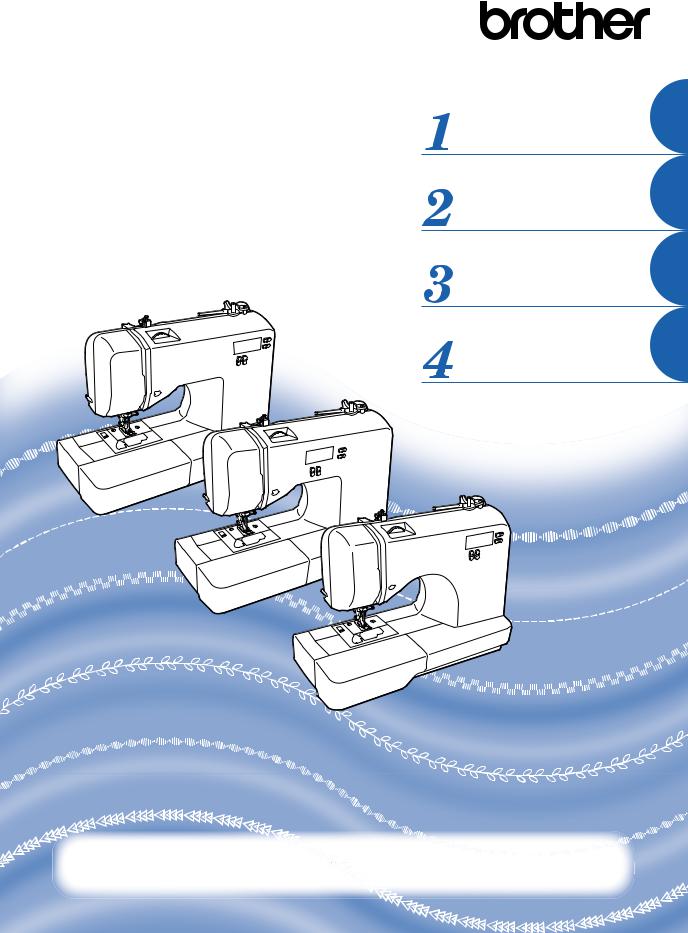
Operation Manual |
SEWING MACHINE |
|
|
KNOWING YOUR |
|
Sewing Machine |
SEWING BASICS |
|
Product Code: 885-E42/E43/E47/E51 |
||
|
||
|
UTILITY STITCHES |
|
|
APPENDIX |
Be sure to read this document before using the machine.
We recommend that you keep this document nearby for future reference.

——————————————————————————————————————————————————————————————————————————————————————————————————————————————————————
IMPORTANT SAFETY INSTRUCTIONS
Please read these safety instructions before attempting to use the machine.
 DANGER - To reduce the risk of electric shock:
DANGER - To reduce the risk of electric shock:
1Always unplug the machine from the electrical outlet immediately after using, when cleaning, when making any user servicing adjustments mentioned in this manual, or if you are leaving the machine unattended.
 WARNING - To reduce the risk of burns, fire, electric shock, or injury to persons.
WARNING - To reduce the risk of burns, fire, electric shock, or injury to persons.
2Always unplug the machine from the electrical outlet when making any adjustments mentioned in the instruction manual:
•To unplug the machine, switch the machine to the symbol “O” position to turn it off, then grasp the plug and pull it out of the electrical outlet. Do not pull on the cord.
•Plug the machine directly into the electrical outlet. Do not use an extension cord.
•Always unplug your machine if the power is cut.
3 Electrical Hazards:
•This machine should be connected to an AC power source within the range indicated on the rating label. Do not connect it to a DC power source or inverter. If you are not sure what kind of power source you have, contact a qualified electrician.
•This machine is approved for use in the country of purchase only.
4 Never operate this machine if it has a damaged cord or plug, if it is not working properly, if it has
been dropped or damaged, or water is spilled on the unit. Return the machine to the nearest authorized dealer or service center for examination, repair, electrical or mechanical adjustment.
•While the machine is stored or in use if you notice anything unusual, such as an odor, heat, discoloration or deformation, stop using the machine and immediately unplug the power cord.
•When transporting the machine, be sure to carry it by its handle. Lifting the machine by any other part may damage the machine or result in the machine falling, which could cause injuries.
•When lifting the machine, be careful not to make any sudden or careless movements, otherwise you may injure your back or knees.
1

————————————————————————————————————————————————————————————————————————————————————————————————————————————————————
5 Always keep your work area clear:
•Never operate the machine with any air openings blocked. Keep ventilation openings of the machine and foot control free from the build up of lint, dust, and loose cloth.
•Do not store objects on the foot controller.
•Do not use extension cords. Plug the machine directly into the electrical outlet.
•Never drop or insert any object into any opening.
•Do not operate where aerosol (spray) products are being used or where oxygen is being administered.
•Do not use the machine near a heat source, such as a stove or iron; otherwise, the machine, power cord or garment being sewn may ignite, resulting in fire or an electric shock.
•Do not place this machine on an unstable surface, such as an unsteady or slanted table, otherwise the machine may fall, resulting in injuries.
6 Special care is required when sewing:
•Always pay close attention to the needle. Do not use bent or damaged needles.
•Keep fingers away from all moving parts. Special care is required around the machine needle.
•Switch the machine to the symbol “O” position to turn it off when making any adjustments in the needle area.
•Do not use a damaged or incorrect needle plate, as it could cause the needle to break.
•Do not push or pull the fabric when sewing, and follow careful instruction when freehand stitching so that you do not deflect the needle and cause it to break.
7 This machine is not a toy:
•Your close attention is necessary when the machine is used by or near children.
•The plastic bag that this machine was supplied in should be kept out of the reach of children or disposed of. Never allow children to play with the bag due to the danger of suffocation.
•Do not use outdoors.
8 For a longer service life:
•When storing this machine, avoid direct sunlight and high humidity locations. Do not use or store the machine near a space heater, iron, halogen lamp, or other hot objects.
•Use only neutral soaps or detergents to clean the case. Benzene, thinner, and scouring powders can damage the case and machine, and should never be used.
•Always consult the operation manual when replacing or installing any assemblies, the presser feet, needle, or other parts to assure correct installation.
9 For repair or adjustment:
•If the light unit (light-emitting diode) is damaged, it must be replaced by authorized dealer.
•In the event a malfunction occurs or adjustment is required, first follow the troubleshooting table in the back of the operation manual to inspect and adjust the machine yourself. If the problem persists, please consult your local authorized Brother dealer.
2

——————————————————————————————————————————————————————————————————————————————————————————————————————————————————————
Use this machine only for its intended use as described in this manual.
Use accessories recommended by the manufacturer as contained in this manual.
The contents of this manual and specifications of this product are subject to change without notice. For additional product information, visit our web site at www.brother.com
SAVE THESE INSTRUCTIONS
This machine is intended for household use.
FOR USERS IN COUNTRIES EXCEPT EUROPEAN COUNTRIES
This appliance is not intended for use by persons (including children) with reduced physical, sensory or mental capabilities, or lack of experience and knowledge, unless they have been given supervision or instruction concerning use of the appliance by a person responsible for their safety. Children should be supervised to ensure that they do not play with the appliance.
FOR USERS IN EUROPEAN COUNTRIES
This appliance can be used by children aged from 8 years and above and persons with reduced physical, sensory or mental capabilities or lack of experience and knowledge if they have been given supervision or instruction concerning use of the appliance in a safe way and understand the hazards involved. Children shall not play with the appliance. Cleaning and user maintenance shall not be made by children without supervision.
FOR USERS IN THE UK, EIRE, MALTA AND
CYPRUS ONLY
IMPORTANT
•In the event of replacing the plug fuse, use a fuse approved by ASTA to BS 1362, i.e. carrying the
 mark, rating as marked on plug.
mark, rating as marked on plug.
•Always replace the fuse cover. Never use plugs with the fuse cover omitted.
•If the available electrical outlet is not suitable for the plug supplied with this equipment, you should contact your authorized dealer to obtain the correct lead.
3

————————————————————————————————————————————————————————————————————————————————————————————————————————————————————
CONTENTS |
|
IMPORTANT SAFETY INSTRUCTIONS ............................................................................... |
1 |
1. KNOWING YOUR SEWING MACHINE .......................................................... |
6 |
ACCESSORIES ..................................................................................................................... |
6 |
Included accessories ........................................................................................................................................ |
6 |
Optional accessories ........................................................................................................................................ |
7 |
Accessory compartment ................................................................................................................................... |
7 |
NAMES OF MACHINE PARTS AND THEIR FUNCTIONS .................................................... |
8 |
The main parts ................................................................................................................................................. |
8 |
Needle and presser foot section ...................................................................................................................... |
9 |
Operation buttons ............................................................................................................................................. |
9 |
Operation panel .............................................................................................................................................. |
10 |
Spool pin ........................................................................................................................................................ |
11 |
Flip chart ........................................................................................................................................................ |
12 |
USING YOUR SEWING MACHINE ................................................................................... |
13 |
Power supply precautions .............................................................................................................................. |
13 |
Power supply .................................................................................................................................................. |
14 |
Foot controller ................................................................................................................................................ |
14 |
Sewing speed controller (for models equipped with the start/stop button) ..................................................... |
15 |
Changing the needle stop position ................................................................................................................. |
15 |
Changing the initial needle position ............................................................................................................... |
15 |
Cancelling the operation beep ....................................................................................................................... |
16 |
THREADING THE MACHINE ............................................................................................ |
17 |
Winding the bobbin ........................................................................................................................................ |
17 |
Lower threading ............................................................................................................................................. |
22 |
Upper threading ............................................................................................................................................. |
25 |
Drawing up the lower thread .......................................................................................................................... |
30 |
REPLACING THE NEEDLE ................................................................................................. |
31 |
Needle precautions ........................................................................................................................................ |
31 |
Needle types and their uses ........................................................................................................................... |
31 |
Checking the needle ...................................................................................................................................... |
32 |
Replacing the needle ..................................................................................................................................... |
32 |
Sewing with the twin needle ........................................................................................................................... |
34 |
REPLACING THE PRESSER FOOT ...................................................................................... |
36 |
Replacing the presser foot ............................................................................................................................. |
36 |
Removing the presser foot holder .................................................................................................................. |
37 |
2. SEWING BASICS ........................................................................................... |
38 |
SEWING ............................................................................................................................ |
38 |
General sewing procedure ............................................................................................................................. |
38 |
Selecting a stitch ............................................................................................................................................ |
39 |
Adjusting the stitch length and width .............................................................................................................. |
40 |
Starting to sew ............................................................................................................................................... |
41 |
Thread tension ............................................................................................................................................... |
43 |
USEFUL SEWING TIPS ...................................................................................................... |
44 |
Trial sewing .................................................................................................................................................... |
44 |
Changing the sewing direction ....................................................................................................................... |
44 |
Sewing curves ................................................................................................................................................ |
44 |
Sewing thick fabrics ....................................................................................................................................... |
44 |
Sewing hook-and-loop fastener tape .............................................................................................................. |
45 |
Sewing thin fabrics ......................................................................................................................................... |
46 |
Sewing stretch fabrics .................................................................................................................................... |
46 |
Stitching cylindrical pieces ............................................................................................................................. |
46 |
3. UTILITY STITCHES ........................................................................................ |
47 |
OVERCASTING STITCHES ................................................................................................ |
47 |
4

——————————————————————————————————————————————————————————————————————————————————————————————————————————————————————
Using zigzag foot ............................................................................................................................................ |
47 |
Using overcasting foot .................................................................................................................................... |
48 |
BASIC STITCHING ............................................................................................................ |
49 |
Basic stitching ................................................................................................................................................ |
49 |
BLIND HEM STITCHING .................................................................................................. |
50 |
BUTTONHOLE SEWING ................................................................................................... |
53 |
Button sewing ................................................................................................................................................. |
57 |
ZIPPER INSERTION ........................................................................................................... |
59 |
SEWING STRETCH FABRICS AND ELASTIC TAPE ............................................................ |
61 |
Stretch stitching .............................................................................................................................................. |
61 |
Elastic attaching ............................................................................................................................................. |
61 |
APPLIQUÉ, PATCHWORK AND QUILT STITCHING ........................................................ |
63 |
Appliqués ....................................................................................................................................................... |
64 |
Patchwork (crazy quilt) stitching ..................................................................................................................... |
64 |
Piecing ........................................................................................................................................................... |
64 |
Quilting ........................................................................................................................................................... |
65 |
Free-motion quilting ....................................................................................................................................... |
66 |
REINFORCEMENT STITCHING ......................................................................................... |
68 |
Triple stretch stitching .................................................................................................................................... |
68 |
Bar tack stitching ............................................................................................................................................ |
68 |
DECORATIVE STITCHING ................................................................................................ |
70 |
Fagoting ......................................................................................................................................................... |
71 |
Scallop stitching ............................................................................................................................................. |
72 |
Smocking ....................................................................................................................................................... |
72 |
Shell tuck stitching ......................................................................................................................................... |
73 |
Joining ............................................................................................................................................................ |
73 |
Heirloom stitching ........................................................................................................................................... |
74 |
SEWING CHARACTERS (for models equipped with character stitches) ............................ |
75 |
Sewing beautiful patterns ............................................................................................................................... |
75 |
Selecting characters ....................................................................................................................................... |
76 |
Checking characters ...................................................................................................................................... |
79 |
Deleting characters ........................................................................................................................................ |
79 |
Sewing the character stitches ........................................................................................................................ |
79 |
ADJUSTING STITCHES (for models equipped with character stitches) ............................. |
80 |
4. APPENDIX ..................................................................................................... |
82 |
STITCH SETTINGS ............................................................................................................. |
82 |
Utility stitches ................................................................................................................................................. |
82 |
Satin stitches .................................................................................................................................................. |
89 |
Mirror image stitches ...................................................................................................................................... |
90 |
Character stitches .......................................................................................................................................... |
93 |
MAINTENANCE ................................................................................................................ |
95 |
Restrictions on oiling ...................................................................................................................................... |
95 |
Precautions on storing the machine ............................................................................................................... |
95 |
Cleaning the machine surface ........................................................................................................................ |
95 |
Cleaning the race ........................................................................................................................................... |
95 |
TROUBLESHOOTING ....................................................................................................... |
98 |
Frequent troubleshooting topics ..................................................................................................................... |
98 |
Upper thread tightened up ............................................................................................................................. |
98 |
Tangled thread on wrong side of fabric .......................................................................................................... |
99 |
Incorrect thread tension ............................................................................................................................... |
102 |
Fabric is caught in the machine and cannot be removed ............................................................................. |
103 |
Error message “E6” appears in the LCD ...................................................................................................... |
107 |
List of symptoms .......................................................................................................................................... |
109 |
ERROR MESSAGES .......................................................................................................... |
114 |
Operation beep ............................................................................................................................................ |
114 |
INDEX ............................................................................................................................. |
115 |
5
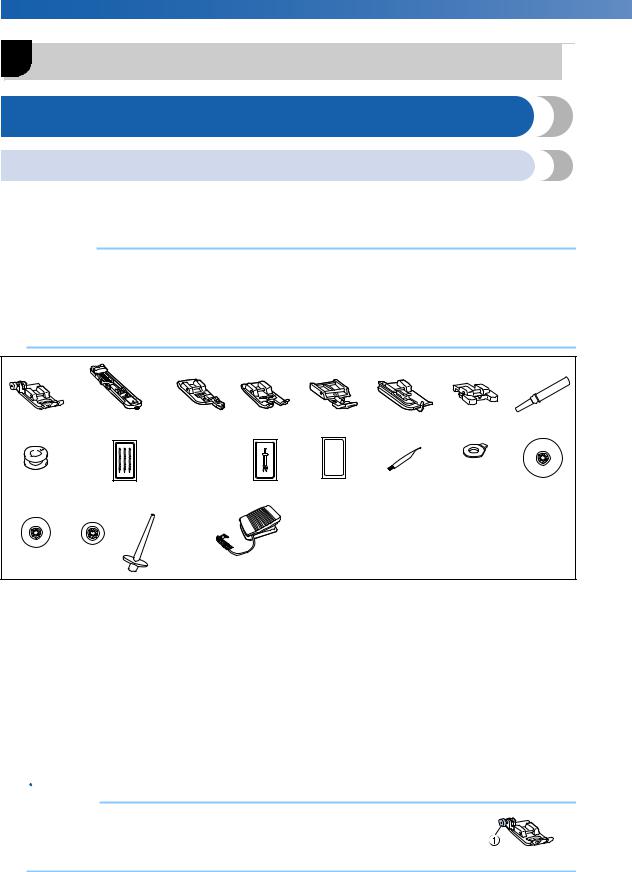
KNOWING YOUR SEWING MACHINE —————————————————————————————————————————————————————————————————————————————————
1 KNOWING YOUR SEWING MACHINE
ACCESSORIES
Included accessories
After opening the box, check that the following accessories are included. If any item is missing or damaged, contact your dealer.
 Note
Note
(For U.S.A. only)
●Foot controller: Model T
This foot controller can be used on the machine with product code 885-E42/E43/E47/E51. The product code is mentioned on the machine rating plate.
●The screw of the presser foot holder is available through your authorized dealer. (Part code: 132730-122)
●The included accessories vary depending on the machine model.
1. |
2. |
3. |
4. |
5. |
6. |
7. |
8. |
9. |
10. |
|
11. |
12. |
13. |
14. |
15. |
75/11 1 needle 90/14 1 needle 100/16 1 needle
90/14 1 needle
16. 17. 18. 19.
No. |
Part Name |
Part Code |
||
Americas |
Others |
|||
|
|
|||
1 |
Zigzag foot “J” (on machine) |
XZ5134-001 |
||
2 |
Buttonhole foot “A” |
XC2691-033 |
||
3 |
Overcasting foot “G” |
XC3098-031 |
||
4 |
Monogramming foot “N” |
XD0810-031 |
||
5 |
Zipper foot “I” |
X59370-021 |
||
6 |
Blind stitch foot “R” |
XE2650-001 |
||
7 |
Button fitting foot “M” |
XE2137-001 |
||
8 |
Seam ripper |
XZ5082-001 |
||
9 |
Bobbin (4) |
SA156 |
SFB: |
|
(One is on machine.) |
XA5539-151 |
|||
10 |
Needle set |
XC8834-021 |
||
No. |
Part Name |
Part Code |
||
Americas |
Others |
|||
|
|
|||
11 |
Twin needle |
131096-121 |
||
12 |
Ball point needle |
XD0360-021 |
||
(gold colored) |
||||
13 |
Cleaning brush |
X59476-021 |
||
14 |
Disc-shaped screwdriver |
XC1074-051 |
||
15 |
Spool cap (large) |
130012-024 |
||
16 |
Spool cap (medium) |
XE1372-001 |
||
|
(on machine) |
|
|
|
17 |
Spool cap (small) |
130013-124 |
||
18 |
Extra spool pin |
XE2241-001 |
||
19 |
Foot controller |
XD0501-121 (EU area) |
||
XC8816-071 (Other areas) |
||||
|
|
|||
 Memo
Memo
● About zigzag foot “J”;
Press the black button on the left side of the foot when it is difficult for thick seams to be fed, for example, at the beginning of sewing thick fabrics. (page 45)
aBlack button
6
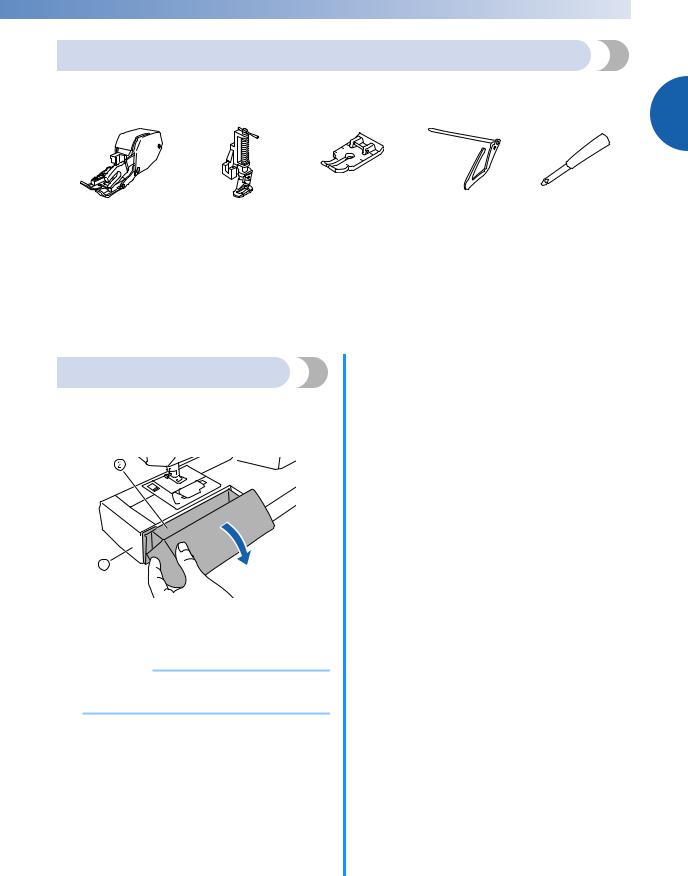
——————————————————————————————————————————————————————————————————————————————————————————————————————————————————————
Optional accessories
The following are available as optional accessories to be purchased separately. Depending on the model you purchased, the following accessory may be included with your machine.
|
|
|
|
|
|
1 |
1. |
2. |
|
3. |
4. |
5. |
|
|
|
|
|
|
|
|
|
|
|
|
|
|
|
|
|
|
|
|
|
|
No. |
Part Name |
Part Code |
||
Americas |
Others |
|||
|
|
|||
1 |
Walking foot |
SA140 |
F033N: |
|
XC2214-052 |
||||
|
|
|
||
2 |
Quilting foot |
SA129 |
F005N: |
|
XC1948-052 |
||||
|
|
|
||
3 |
1/4-inch quilting foot |
SA125 |
F001N: |
|
XC1944-052 |
||||
|
|
|
||
No. |
Part Name |
Part Code |
||
Americas |
Others |
|||
|
|
|||
4 |
Quilting guide |
SA132 |
F016N: |
|
XC2215-052 |
||||
|
|
|
||
5 |
Eyelet punch |
XZ5051-001 |
||
Accessory compartment
The accessories are stored in a compartment inside the flat bed attachment. Open the compartment as shown in the figure below.
aFlat bed attachment
bStorage compartment
 Note
Note
●Store the accessories in the compartment when they are not used.
7
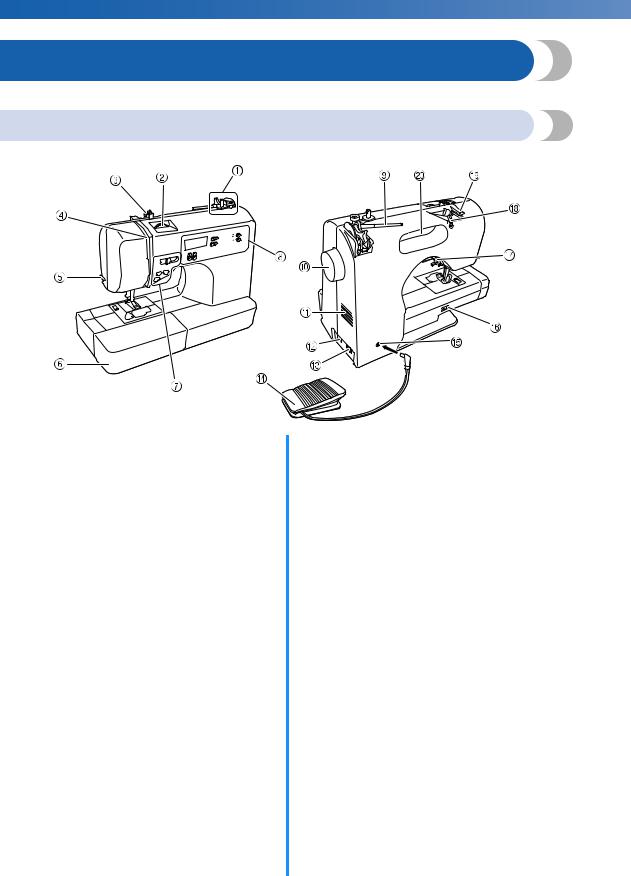
KNOWING YOUR SEWING MACHINE —————————————————————————————————————————————————————————————————————————————————
NAMES OF MACHINE PARTS AND THEIR FUNCTIONS
The illustrations in this operation manual may differ from the actual machine.
The main parts
aBobbin winder (page 17)
This winds the thread onto the bobbin for use as the lower thread.
bUpper tension-control dial (page 43)
This controls the tension of the upper thread.
cBobbin-winding thread guide and pre-tension disc (page 19)
Pass the thread under this thread guide and around the pre-tension disc when winding the bobbin thread.
dThread take-up lever (page 27)
eThread cutter (page 42)
Pass the threads through the thread cutter to cut them.
fFlat bed attachment with accessory compartment (page 7 and 46)
gOperation buttons (page 9)
The operation buttons differ depending on the sewing machine model.
hOperation panel (page 10)
This is used to select the stitch and specify the various settings. Design and position of the operation panel differs depending on the sewing machine model.
iSpool pin (page 11, 17 and 25)
This holds the spool of thread.
jHandwheel
This is used to manually raise and lower the needle.
kAir vent
This vent allows the air surrounding the motor to circulate. Do not cover the air vent while the sewing machine is being used.
lMain power and sewing light switch (page 14)
You can turn the main power and sewing light switch on and off.
mJack/socket connector (page 14)
Insert the plug on the power supply cord into the jack/ socket connector.
nFoot controller (page 14)
You can use this to control the sewing speed, and to start and stop sewing.
oFoot controller jack/socket (page 14)
Plug in the foot controller plug.
pFeed dog position lever (page 57 and 67)
Use the feed dog position lever to lower the feed dogs.
qPresser foot lever (page 25)
This is used to raise and lower the presser foot.
rThread guide (page 18 and 27)
This is used when winding the thread onto the bobbin and then threading the machine.
sThread guide cover (page 18 and 27)
Pass the thread under this thread guide when winding the bobbin thread and threading the machine.
tHandle
Carry the sewing machine by its handle when transporting the machine.
8
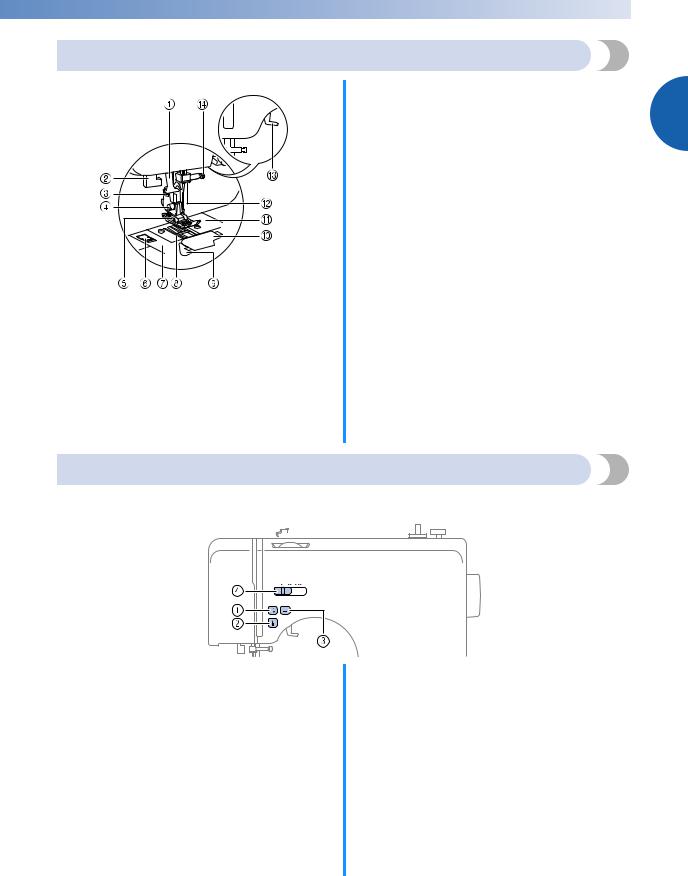
——————————————————————————————————————————————————————————————————————————————————————————————————————————————————————
Needle and presser foot section
aNeedle threader (for models equipped with the needle threader) (page 28)
bButtonhole lever
Lower the buttonhole lever when sewing buttonholes and bar tacks.
cPresser foot holder
The presser foot is installed onto the presser foot holder.
dPresser foot holder screw
Use the presser foot holder screw to hold the presser foot holder in place.
e Presser foot
The presser foot applies pressure consistently on the
fabric as the sewing takes place. Attach the appropriate 1 presser foot for the selected stitching.
fNeedle plate cover release
Use when removing the needle plate cover.
gNeedle plate cover
Remove the needle plate cover to clean the race.
hFeed dogs
The feed dogs feed the fabric in the sewing direction.
iQuick-set bobbin (for models equipped with the quickset bobbin)
You can start sewing without pulling up the bobbin thread.
jBobbin cover
Open the bobbin cover to set the bobbin.
kNeedle plate
The needle plate is marked with guides for sewing straight seams.
lNeedle bar thread guide
Pass the upper thread through the needle bar thread guide.
mPresser foot lever
Raise and lower the presser foot lever to raise and lower the presser foot.
nNeedle clamp screw
Use the needle clamp screw to hold the needle in place.
Operation buttons
The operation buttons help you to easily perform various basic sewing machine operations. The operation buttons differ depending on the sewing machine model.
aReverse/reinforcement stitch button 
Press the reverse/reinforcement stitch button to sew reverse stitches. Reverse stitches are sewn by keeping the button pressed down to sew in the opposite direction. For details, refer to “Sewing reinforcement stitches” (page 42).
bStart/stop button 
Press the start/stop button to start or stop sewing. The machine sews at a slow speed at the beginning of sewing while the button is pressed. When sewing is stopped, the needle is lowered in the fabric. For details, refer to “Starting to sew” (page 41).
cNeedle position button 
Press the needle position button to raise or lower the needle. Be sure to raise the needle before threading the needle. Use this button to change the sewing direction or for detailed sewing in small areas. Pressing the button twice sews one stitch.
dSewing speed controller
Slide the sewing speed controller to adjust the sewing speed.
9
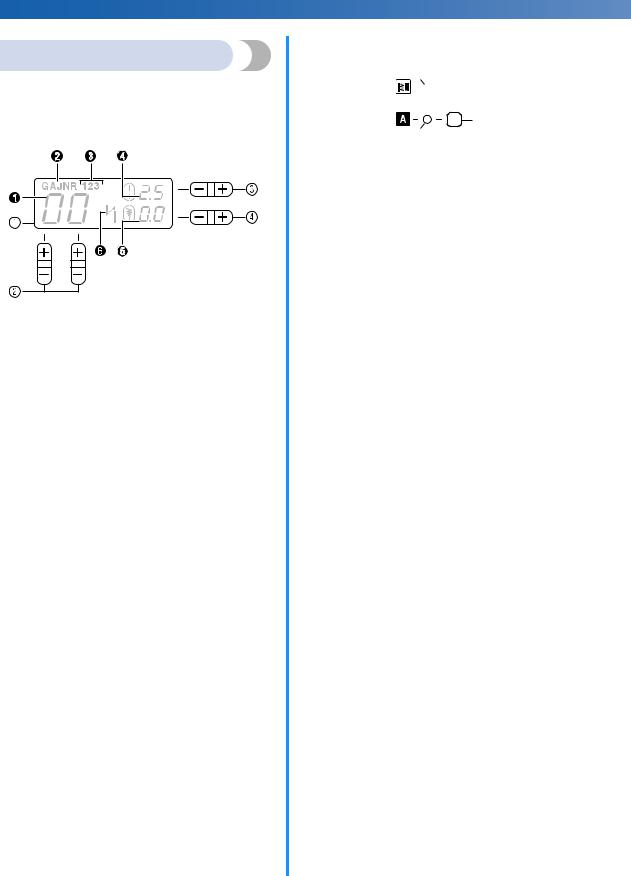
KNOWING YOUR SEWING MACHINE —————————————————————————————————————————————————————————————————————————————————
Operation panel
The operation panel, located on the front of the sewing machine, allows you to select a stitch and specify how the stitch will be sewn.
The operation panel differs depending on the sewing machine model.
aLCD (liquid crystal display)
1 The number of the selected stitch
2 The presser foot type to be used
3 The selected stitch type number
4 The stitch length (mm)
5 The stitch width (mm)
6 The auto reverse/reinforcement
bStitch selection keys
Press the stitch selection keys, and then select the number for the stitch that you wish to use. For details, refer to “Selecting a stitch” (page 39).
cStitch length adjustment key
Press this key to adjust the stitch length. (Press the “–” side to reduce the stitch length; press the “+” side to increase the stitch length.)
dStitch width adjustment key
Press this key to adjust the stitch width. (Press the “–” side to reduce the stitch width; press the “+” side to increase the stitch width.)
■ Keys and indicators
f



 e
e
g
h
eUtility stitch key
Press this key to select the desired type of utility stitches. Press this key once or more until the desired stitch type number is displayed on the LCD. For details, refer to “Selecting a stitch” (page 39).
fUtility stitch indicator
This indicator lights up when the utility stitch is selected.
gCharacter stitch key
Press this key to select the desired font type of character stitches. Press this key once or more until the desired stitch type number is displayed on the LCD. For details, refer to “Selecting characters” (page 76).
hCharacter stitch indicator
This indicator lights up when the character stitch is selected.
10
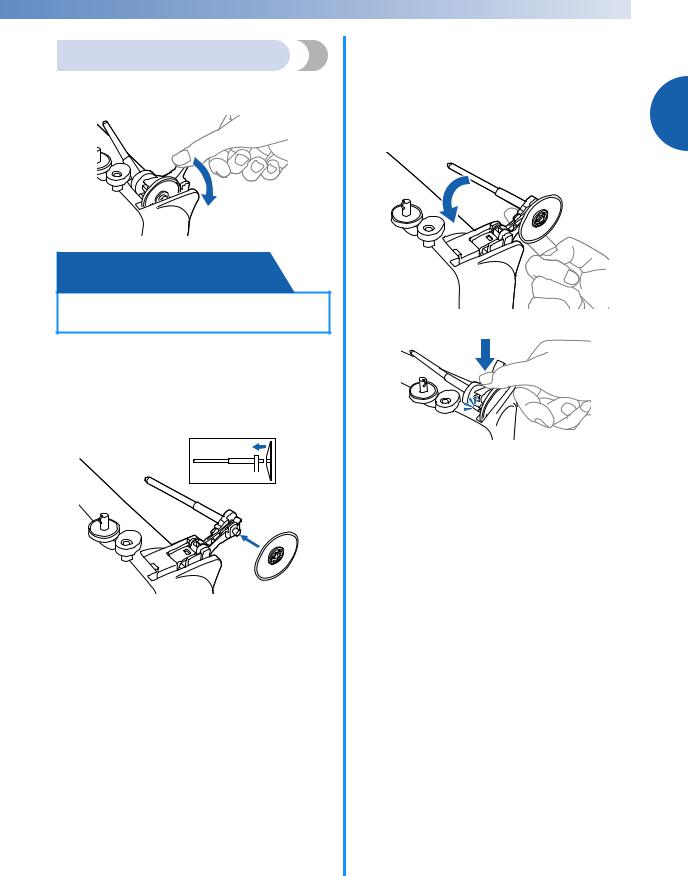
——————————————————————————————————————————————————————————————————————————————————————————————————————————————————————
Spool pin
As shown, press down on the spool pin lever with your finger to raise the spool pin.
 CAUTION
CAUTION
●Do not grab the bar to raise the spool pin, otherwise, the spool pin may bend or break.
■Storing the spool cap
The enclosed spool cap (large, medium, small) can be stored by attaching it to the spool pin as shown in the illustration. When attaching the spool cap, position it with the rounded side toward the spool pin.
■Storing the spool pin
When placing the cover on the sewing machine before storing or if the spool pin will not be used,
return the spool pin to its storage position. Remove the spool from the spool pin, and then
fold up the spool pin, as shown in the illustration, 1 until it snaps into place to secure it.
11
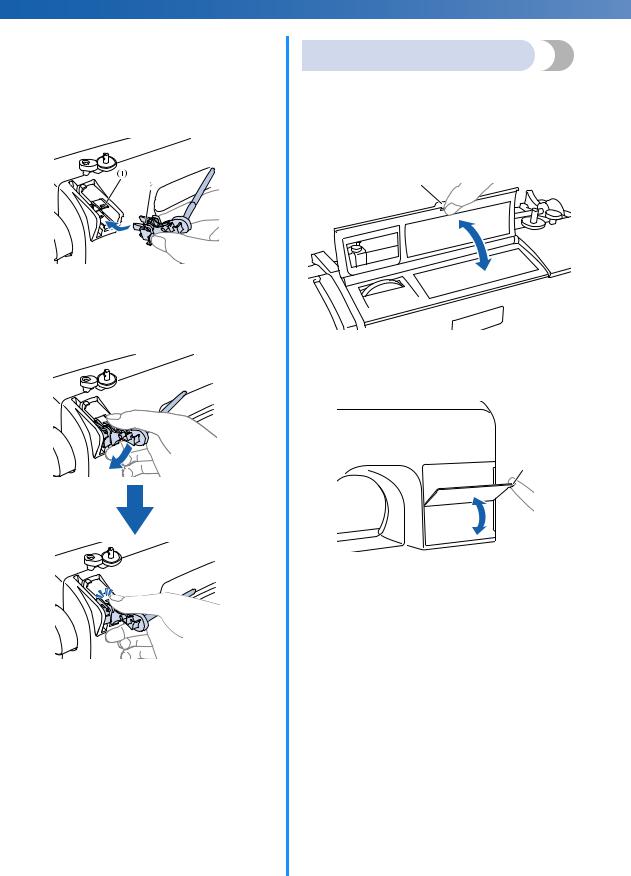
KNOWING YOUR SEWING MACHINE —————————————————————————————————————————————————————————————————————————————————
■ Installing the spool pin
aIf the spool pin has been removed from the machine, insert the tab on the spool pin into the hole on the back of the machine, as shown.
aHole
bTab
bPushplace.the spool pin down until it locks into
Flip chart
You can check the pattern numbers of the stitches using the flip chart on the machine.
Hold the notch with your finger to flip the chart.
For models equipped with a flip chart on the top panel
1
For models equipped with a flip chart on the front panel
1
a Notch
12
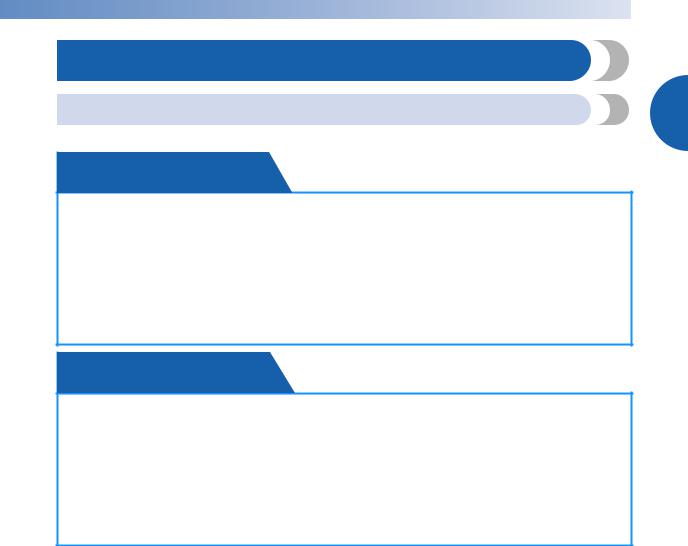
——————————————————————————————————————————————————————————————————————————————————————————————————————————————————————
USING YOUR SEWING MACHINE
Power supply precautions |
1 |
|
Be sure to observe the following precautions concerning the power supply.
 WARNING
WARNING
●Use only regular household electricity for the power source. Using other power sources may result in fire, electric shock, or damage to the machine.
●Make sure that the plugs on the power cord are firmly inserted into the electrical outlet and the power supply jack on the machine. Otherwise, a fire or electric shock may result.
●Do not insert the plug on the power cord into an electrical outlet that is in poor condition.
●Turn off the main power and remove the plug in the following circumstances:
•When you are away from the machine
•After using the machine
•When the power fails during use
•When the machine does not operate correctly due to a bad connection or a disconnection
•During electrical storms
 CAUTION
CAUTION
●Use only the power cord included with this machine.
●Do not use extension cords or multi-plug adapters with many other appliances plugged in to them. Fire or electric shock may result.
●Do not touch the plug with wet hands. Electric shock may result.
●When unplugging the machine, always turn off the main power first. Always grasp the plug to remove it from the outlet. Pulling on the cord may damage the cord, or lead to fire or electric shock.
●Do not allow the power cord to be cut, damaged, modified, forcefully bent, pulled, twisted, or bundled. Do not place heavy objects on the cord. Do not subject the cord to heat. These things may damage the cord and cause fire or electric shock. If the cord or plug is damaged, take the machine to your authorized dealer for repairs before continuing use.
●Unplug the power cord if the machine is not to be used for a long period of time. Otherwise a fire may result.
13
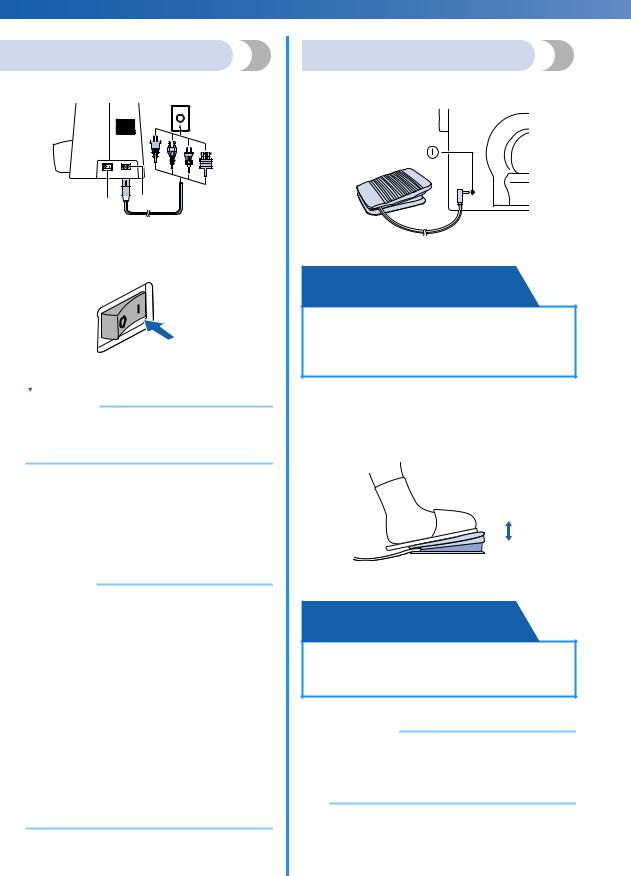
KNOWING YOUR SEWING MACHINE —————————————————————————————————————————————————————————————————————————————————
Power supply
aInsert the plug into a wall outlet.
1  2
2
aMain power switch
bJack/socket connector
bSet the main power switch to “I”.
XThe sewing light comes on when the machine is turned on.
 Memo
Memo
●When the machine is turned on, the needle and the feed dogs will make sound when they move; this is not a malfunction.
cTo turn off the machine, set the main power switch to “{”.
XThe sewing light goes off when the machine is turned off.
 Note
Note
●If a power outage occurs while the sewing machine is being operated, turn off the sewing machine and unplug the power supply cord. When restarting the sewing machine, follow the necessary procedure to correctly operate the machine.
(For U.S.A. only)
●This appliance has a polarized plug (one blade wider than the other). To reduce the risk of electric shock, this plug is intended to fit in a polarized outlet only one way. If the plug does not fit fully in the outlet, reverse the plug.
If it still does not fit, contact a qualified electrician to install the proper outlet. Do not modify the plug in any way.
Foot controller
Insert the foot controller plug into its jack/socket on the rear side of the sewing machine.
a Foot controller jack/socket
 CAUTION
CAUTION
●When connecting the foot controller, be sure to turn off the sewing machine in order to prevent the machine from accidentally being started.
When you press the foot controller down lightly, the machine will run at a low speed. When you press harder, the machine’s speed will increase. When you take your foot off the foot controller, the machine will stop.
Slower
Faster
You should make sure that nothing is placed on the foot controller when the machine is not in use.
 CAUTION
CAUTION
●Do not allow pieces of cloth and dust to build up on the foot controller. Doing so could cause a fire or an electric shock.
 Note
Note
●When the foot controller is plugged in, the start/stop button cannot be used to start sewing (only for models equipped with the start/stop button).
14
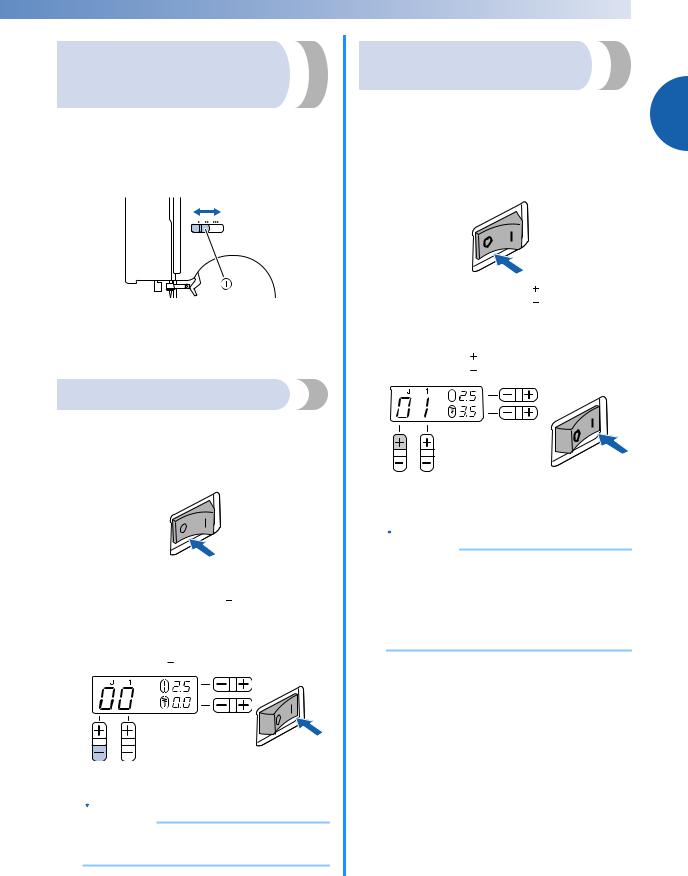
——————————————————————————————————————————————————————————————————————————————————————————————————————————————————————
Sewing speed controller (for models equipped with the start/stop button)
aSlide the sewing speed controller to the left or right to select the desired sewing speed.
Slide the sewing speed controller to the left to sew at a slower speed, or slide the speed controller to the right to sew at a faster speed.
a Sewing speed controller
•The speed set using the sewing speed controller is the foot controller’s maximum sewing speed.
Changing the needle stop position
Normally, the sewing machine is set to leave the needle in the fabric when sewing is stopped. Instead, the machine can be set to leave the needle raised when sewing is stopped.
aTurn off the sewing machine.
bHold down the “–” side of  (stitch selection
(stitch selection
key) on the left and turn on the sewing machine.
After turning on the sewing machine, release the “–” side of  (stitch selection key).
(stitch selection key).
XThe needle stop position changes to the raised position.
 Memo
Memo
•Perform the same operation to change the needle stop position to the lowered position.
Changing the initial needle position
Normally, the straight stitch (left needle position) is automatically selected when the sewing machine is 1 turned on. The machine can be set so that the
straight stitch (center needle position) is automatically selected when it is turned on.
aTurn off the sewing machine.
bHold down the “+” side of  (stitch selection key) on the left and turn on the sewing machine.
(stitch selection key) on the left and turn on the sewing machine.
After turning on the sewing machine, release the “+” side of  (stitch selection key).
(stitch selection key).
XThe initial needle position changes to the center needle position.
 Memo
Memo
●The specified initial needle position is maintained even after the machine is turned off.
●Perform the same operation to change the initial needle position to the left needle position.
15
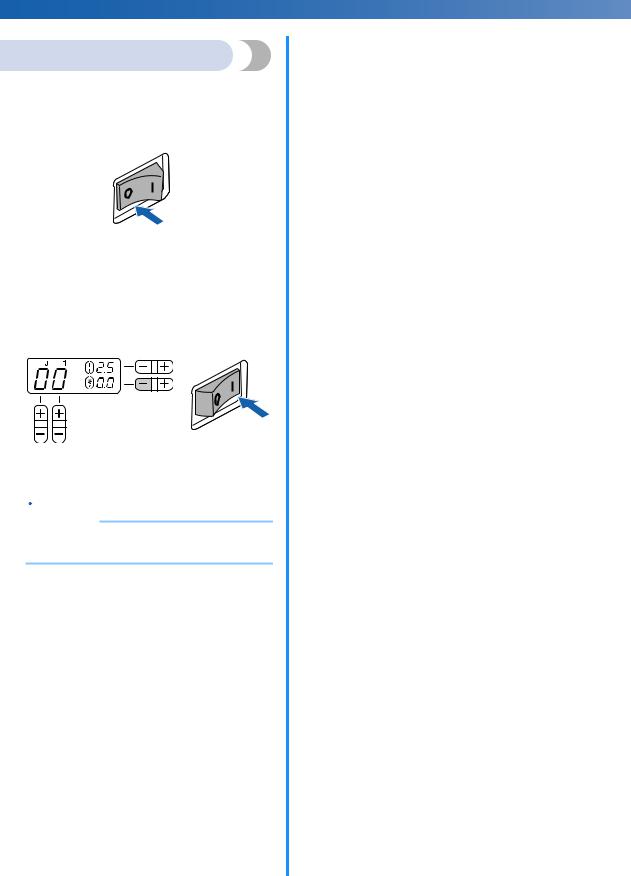
KNOWING YOUR SEWING MACHINE —————————————————————————————————————————————————————————————————————————————————
Cancelling the operation beep
When the sewing machine is purchased, it is set to beep each time a key is pressed. This setting can be changed so that the machine does not beep.
aTurn off the sewing machine.
bHold down the “–” side of 
 (stitch width adjustment key) and turn on the sewing machine.
(stitch width adjustment key) and turn on the sewing machine.
After turning on the sewing machine, release the “-” side of 
 (stitch width adjustment key).
(stitch width adjustment key).
XThe machine is now set so that it will not beep.
 Memo
Memo
●Perform the same operation to change the setting so that machine beeps.
16
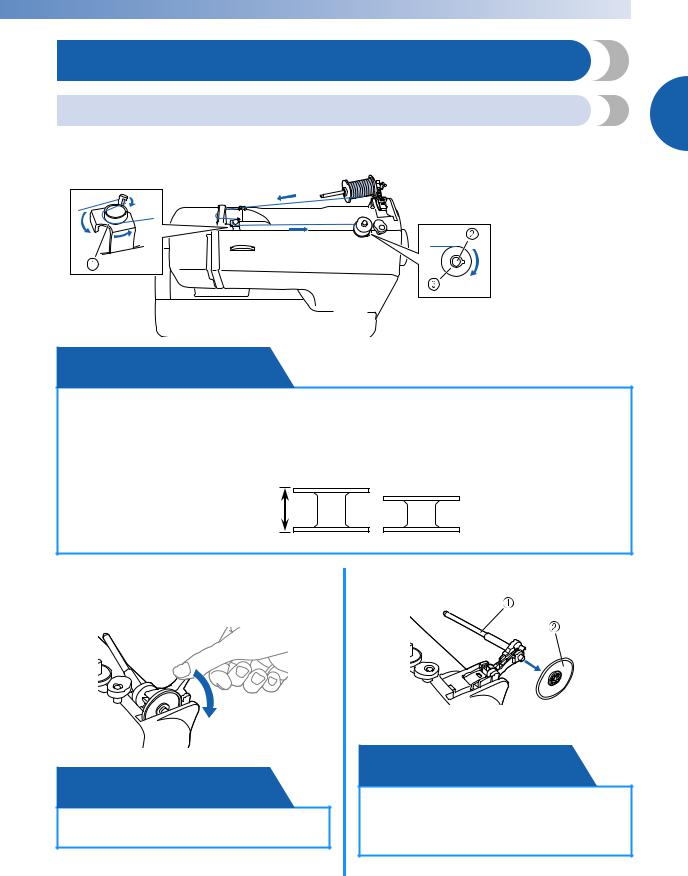
——————————————————————————————————————————————————————————————————————————————————————————————————————————————————————
THREADING THE MACHINE
Winding the bobbin |
1 |
|
This section describes how to wind the thread onto the bobbin.
• For details on the fast bobbin winding, see page 20.
a Bobbin-winding thread guide
b Bobbin winder shaft c Bobbin
 CAUTION
CAUTION
●Only use bobbins (part code: SA156, SFB: XA5539-151) that have been designed for this sewing machine. Using other bobbins may cause damage to the machine.
●We designed the bobbin that comes with this machine. If you use bobbins from other models, the machine will not work properly. Only use the bobbin that comes with this machine or bobbins of the same type (part code: SA156, SFB: XA5539-151).
Actual size
11.5 mm (7/16 inch)
This model |
Other models |
aAs shown, press down on the spool pin lever with your finger.
X The spool pin swings up.
 CAUTION
CAUTION
●Do not grab the bar to raise the spool pin, otherwise, the spool pin may bend or break.
bRemove the spool cap.
aSpool pin
bSpool cap
 CAUTION
CAUTION
●Be sure to raise the spool pin when winding the bobbin. The thread may become tangled if the bobbin winder is used without raising the spool pin.
17

KNOWING YOUR SEWING MACHINE —————————————————————————————————————————————————————————————————————————————————
cFully insert the spool of thread for the bobbin onto the spool pin.
Slide the spool onto the pin so that the spool is horizontal and the thread unwinds to the front at the bottom.
dSlide the spool cap onto the spool pin.
With the slightly rounded side of the spool cap positioned toward the left, slide the spool cap onto the spool pin as far as possible to the right so that the spool is moved to the right end of the spool pin.
 CAUTION
CAUTION
●If the spool or the spool cap is not positioned correctly, the thread may become tangled around the spool pin or the machine may be damaged.
●Three spool cap sizes are available, allowing you to choose a spool cap that best fits the size of spool being used. If the spool cap is too small for the spool being used, the thread may catch on the slit in the spool or the machine may be damaged.
 Memo
Memo
●When sewing with fine, cross-wound thread, use the small spool cap, and leave a small space between the cap and the spool.
c b
a 
aSpool cap (small)
bSpool (cross-wound thread)
cSpace
eWhile holding the spool with your right hand, and then pass the thread under the thread guide.
a Thread guide
fPass the thread under the thread guide cover from the back to the front.
Hold the thread with your right hand so that there is no slack in the thread that is pulled out, and then pass the thread under the thread guide cover with your left hand.
a Thread guide cover
18
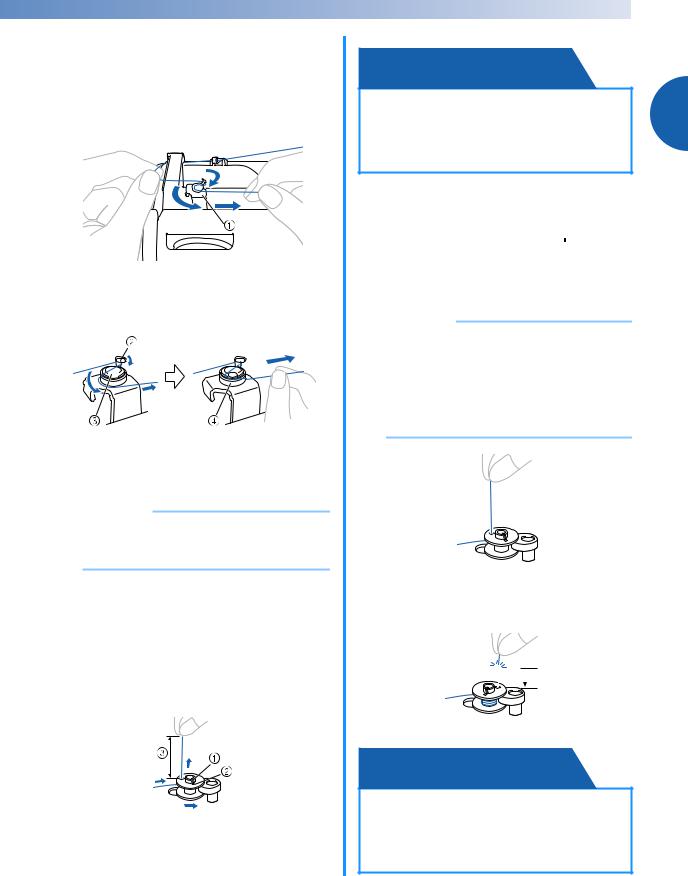
——————————————————————————————————————————————————————————————————————————————————————————————————————————————————————
gPull the thread to the right, pass it under the hook of the bobbin-winding thread guide, and then wind the thread counterclockwise between the discs, pulling it in as far as possible.
a Bobbin-winding thread guide
Make sure that the thread passes under the pre-tension disk.
bHook
cPre-tension disk
dPull it in as far as possible.
 Note
Note
●Make sure that the thread is pulled as far as possible into the pre-tension disk, otherwise the bobbin may not be wound cleanly.
hPut the bobbin onto the bobbin winder shaft and slide the bobbin winder shaft to the right. Turn the bobbin clockwise, by hand, until the spring on the shaft slides into the notch in the bobbin.
•Make sure to pull out 7 to 10 cm (3 to 4 inches) of thread from the hole on the bobbin.
aSpring on the shaft
bNotch
c7 – 10 cm (3 – 4 inches)
 CAUTION
CAUTION
● Pull the thread taut and hold the end of the |
1 |
thread straight up. If the thread is too short, |
|
not pulled taut or held at an angle, injuries |
|
may occur when the thread is wound around |
|
the bobbin. |
|
iTurn on the sewing machine.
jWhile holding the end of the thread, gently press the foot controller or press  (start/stop button) (for models equipped with the start/ stop button) to wind the thread around the bobbin a few times. Then stop the machine.
(start/stop button) (for models equipped with the start/ stop button) to wind the thread around the bobbin a few times. Then stop the machine.
 Note
Note
●If the sewing machine is to be operated using the foot controller, connect the foot controller before turning on the machine.
●When the foot controller is plugged in, the start/stop button cannot be used to start sewing (only for models equipped with the start/stop button).
kTrim the excess thread above the bobbin.
•Pull 1 cm (1/2 inch) of thread from the hole on the bobbin.

 1
1
a 1 cm (1/2 inch)
 CAUTION
CAUTION
●Make sure you follow the instructions carefully. If you do not cut the thread completely, and the bobbin is wound, when the thread runs low it may tangle around the bobbin and cause the needle to break.
19
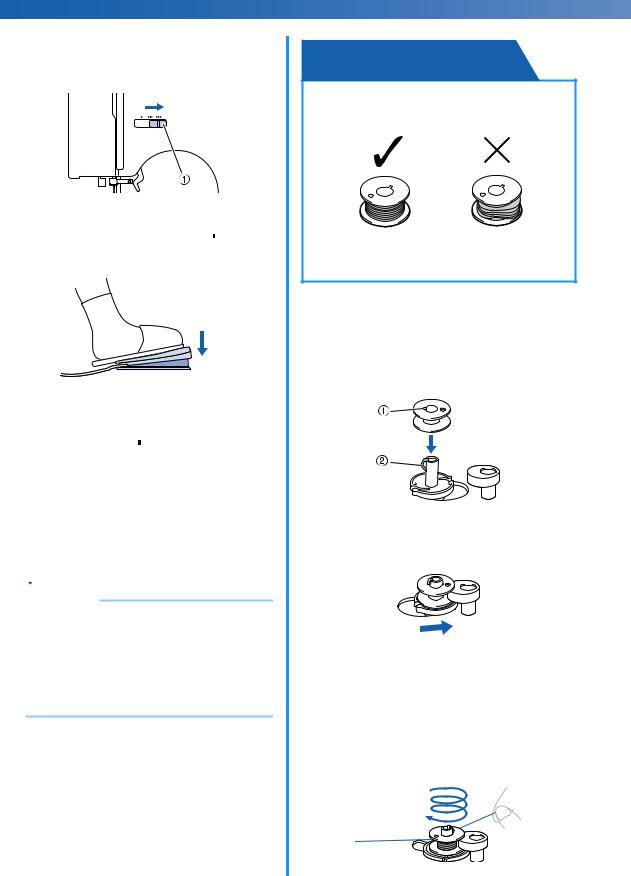
KNOWING YOUR SEWING MACHINE —————————————————————————————————————————————————————————————————————————————————
lSlide the sewing speed controller to the right (to set the speed to fast). (For models equipped with the sewing speed controller.)
a Sewing speed controller
mPress the foot controller or press  (start/ stop button) (for models equipped with the start/stop button) to start.
(start/ stop button) (for models equipped with the start/stop button) to start.
nWhen the bobbin seems full and begins spinning slowly, take your foot off the foot controller or press  (start/stop button) (for models equipped with the start/stop button).
(start/stop button) (for models equipped with the start/stop button).
oCut the thread, slide the bobbin winder shaft to the left and remove the bobbin.
pSlide the sewing speed controller back to its original position (for models equipped with the sewing speed controller).
 Memo
Memo
●When the sewing machine is started or the handwheel is turned after winding the thread around the bobbin, the machine will make a clicking sound; this is not a malfunction.
●The needle bar does not move when you slide the bobbin winding shaft to the right.
 CAUTION
CAUTION
●Not winding the bobbin properly may cause the thread tension to loosen, and may break the needle.
1 2
aWound evenly
bWound poorly
■For models equipped with the fast bobbin winding system
aPlace the bobbin on the bobbin winder shaft so that the spring on the shaft fits into the notch in the bobbin.
aNotch
bBobbin winder shaft spring
bSlide the bobbin winder shaft to the right.
cFollow steps a through g of the procedure in “Winding the bobbin” to pass the thread around the pre-tension disk (page 17).
dWhile holding the thread that wraps around the pre-tension disk with your left hand, use your right hand to wind the free end of the thread clockwise around the bobbin five or six times.
20
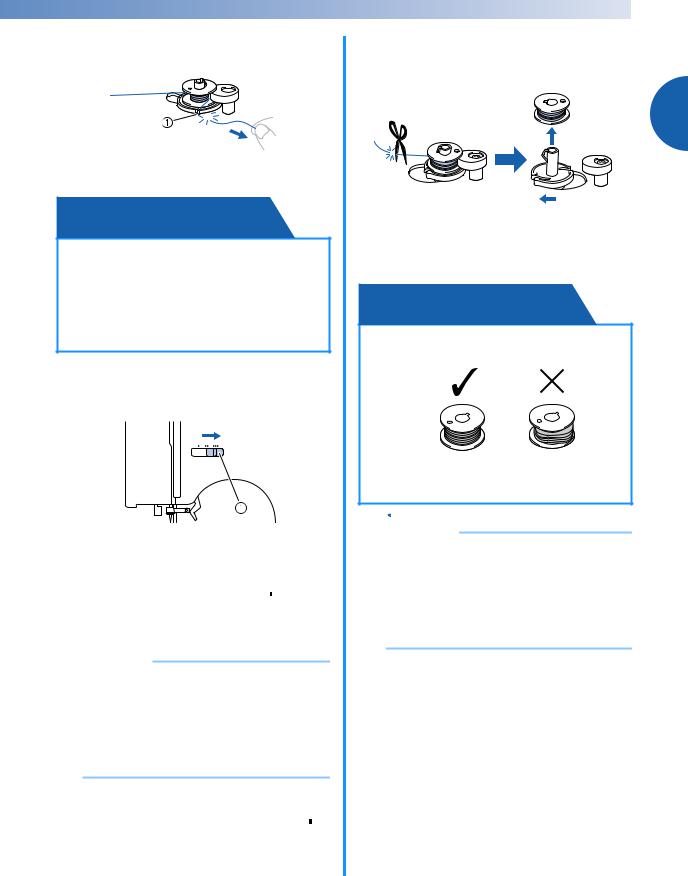
——————————————————————————————————————————————————————————————————————————————————————————————————————————————————————
ePull the thread to the right and pass it through the slit in the bobbin winder seat.
a Slit in bobbin winder seat (with built-in cutter)
X The thread is cut to a suitable length.
 CAUTION
CAUTION
●Be sure to cut the thread as described. If the bobbin is wound without cutting the thread using the cutter built into the slit in the bobbin winder seat, the thread may become tangled in the bobbin or the needle may bend or break when the bobbin thread starts to run out.
fSlide the sewing speed controller to the right (to set the speed to fast) (for models equipped with the sewing speed controller).
a Sewing speed controller
gTurn on the sewing machine.
hPress the foot controller or press  (start/ stop button) (for models equipped with the start/stop button) to start.
(start/ stop button) (for models equipped with the start/stop button) to start.
 Note
Note
●If the sewing machine is to be operated using the foot controller, connect the foot controller before turning on the machine.
●When the foot controller is plugged in, the start/stop button cannot be used to start sewing (only for models equipped with the start/stop button).
iWhen the bobbin begins spinning slowly, take your foot off the foot controller or press  (start/stop button) (for models equipped with the start/stop button).
(start/stop button) (for models equipped with the start/stop button).
jCut the thread, slide the bobbin winder shaft to the left, and then remove the bobbin from the shaft.
1
kSlide the sewing speed controller back to its original position (for models equipped with the sewing speed controller).
 CAUTION
CAUTION
●Not winding the bobbin properly may cause the thread tension to loosen, and may break the needle.
1 2
aWound evenly
bWound poorly
 Memo
Memo
●When the sewing machine is started or the handwheel is turned after winding the thread around the bobbin, the machine will make a clicking sound; this is not a malfunction.
●The needle bar does not move when you slide the bobbin winding shaft to the right.
21
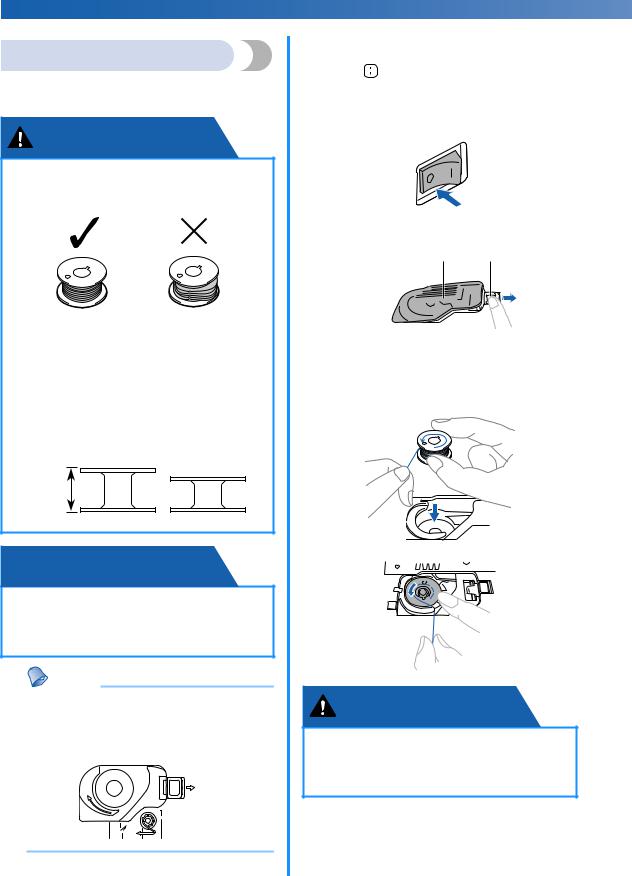
KNOWING YOUR SEWING MACHINE —————————————————————————————————————————————————————————————————————————————————
|
Raise the needle to its highest position by turning |
||
Lower threading |
athe handwheel toward you (counterclockwise) or |
||
Install the bobbin wound with thread. |
press |
(needle position button) (for models |
|
equipped with the needle position button), and |
|||
• For more details on quick-set bobbin, see page 23. |
|||
raise the presser foot lever. |
|||
|
|||
CAUTION |
bTurn off the sewing machine. |
||
●Winding the bobbin improperly may cause the thread tension to loosen, breaking the needle and resulting in injury.
cSlide the button and open the cover.
1 2
1 |
2 |
|
a Wound evenly |
|
a Cover |
b Wound poorly |
|
b Slide button |
● The bobbin was designed specifically for this |
Put the bobbin in so the thread comes out in |
|
sewing machine. If bobbins from other |
||
models are used, the machine will not operate |
dthe direction shown by the arrow. |
|
correctly. Use only the enclosed bobbin or |
|
|
bobbins of the same type (part code: SA156, |
|
|
SFB: XA5539-151). |
|
|
Actual size |
|
|
11.5 mm |
|
|
(7/16 inch) |
|
|
This model |
Other models |
|
 CAUTION
CAUTION
● Make sure you turn the power off while threading the machine. If you accidentally step on the foot controller and the machine starts to sew, you could be injured.
|
Memo |
CAUTION |
● |
is indicated by marks on the needle plate |
|
The direction for feeding the bobbin thread |
|
|
|
cover. Be sure to thread the machine as |
● Make sure you set the bobbin so the thread |
|
indicated. |
|
|
|
unrolls in the right direction. If the thread unrolls |
|
|
in the wrong direction, it may cause the thread |
|
|
tension to be incorrect or break the needle. |
22
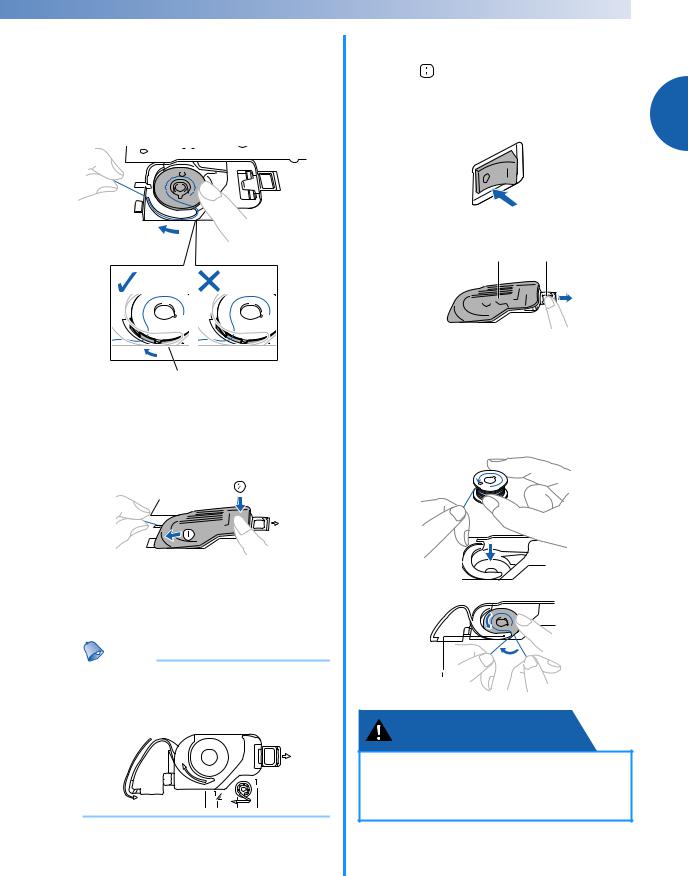
——————————————————————————————————————————————————————————————————————————————————————————————————————————————————————
Hold the end of the thread, push the bobbin |
Raise the needle to its highest position by turning |
|||||||||
edown with your finger, and then pass the |
athe handwheel toward you (counterclockwise) or |
|||||||||
thread through the slit, as shown. |
press |
(needle position button) (for models |
||||||||
• If the thread is not correctly inserted through |
equipped with the needle position button), and |
|||||||||
the tension-adjusting spring of the bobbin |
raise the presser foot lever. |
|||||||||
case, it may cause incorrect thread tension |
|
1 |
||||||||
|
|
|||||||||
(page 43). |
bTurn off the sewing machine. |
|||||||||
|
|
|
|
|
|
|
|
|
|
|
cSlide the button and open the cover.
1 2
|
a Cover |
|
b Slide button |
1 |
dInsert the bobbin with your right hand so that the |
a Tension-adjusting spring |
end of the thread is on the left, and then, after |
|
pulling the thread firmly around the tab with your |
Replace the bobbin cover. Put the left tab in |
left hand as shown, lightly pull the thread to |
fplace (see arrow a), and then press lightly on |
guide it through the slit. |
the right side (see arrow b) until the cover |
|
clicks into place. |
|
• Replace the cover so that the end of the thread comes out from the left side of the cover (as shown by the line in the diagram).
■ For models equipped with the quick-set bobbin
Memo |
|
● The direction for feeding the bobbin thread |
|
is indicated by marks on the needle plate |
a Tab |
cover. Be sure to thread the machine as |
|
indicated. |
CAUTION |
|
|
|
● Make sure you set the bobbin so the thread |
|
unrolls in the right direction. If the thread unrolls |
|
in the wrong direction, it may cause the thread |
|
tension to be incorrect or break the needle. |
23
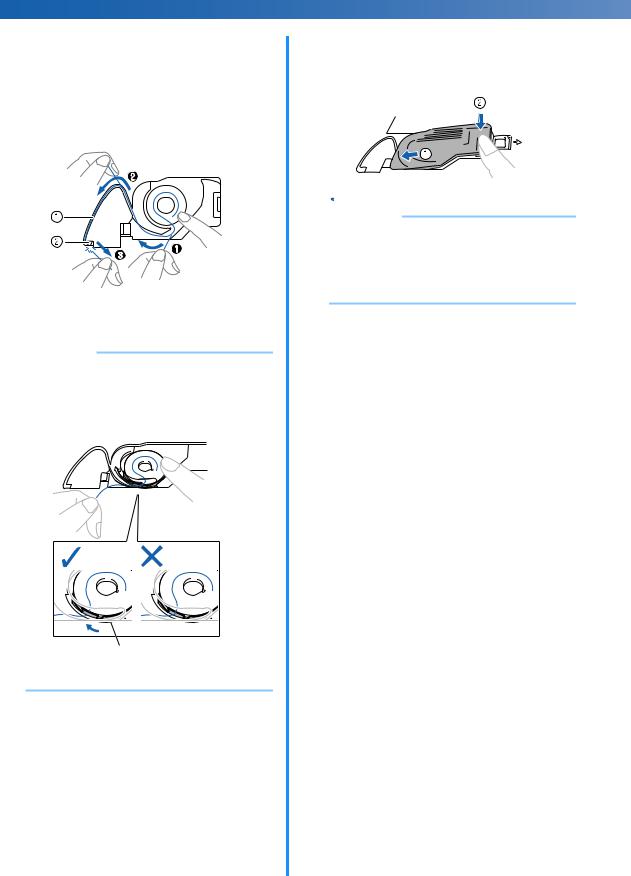
KNOWING YOUR SEWING MACHINE —————————————————————————————————————————————————————————————————————————————————
eWhile lightly holding down the bobbin with your right hand as shown, guide the thread through the slit (a and b).
•At this time, check that the bobbin easily rotates counterclockwise.
Then, pull the thread toward you to cut it with the cutter (c).
aSlit
bCutter (Cut the thread with the cutter.)
 Note
Note
●If the thread is not correctly inserted through the tension-adjusting spring of the bobbin case, it may cause incorrect thread tension (page 43).
fReplace the bobbin cover. Put the left tab in place (see arrow a), and then press lightly on the right side (see arrow b) until the cover clicks into place.
 Memo
Memo
●You can begin sewing immediately without drawing up the bobbin thread. If you want to draw up the bobbin thread before you start to sew, follow to the procedure in “Drawing up the lower thread” (page 30).
1
a Tension-adjusting spring
24
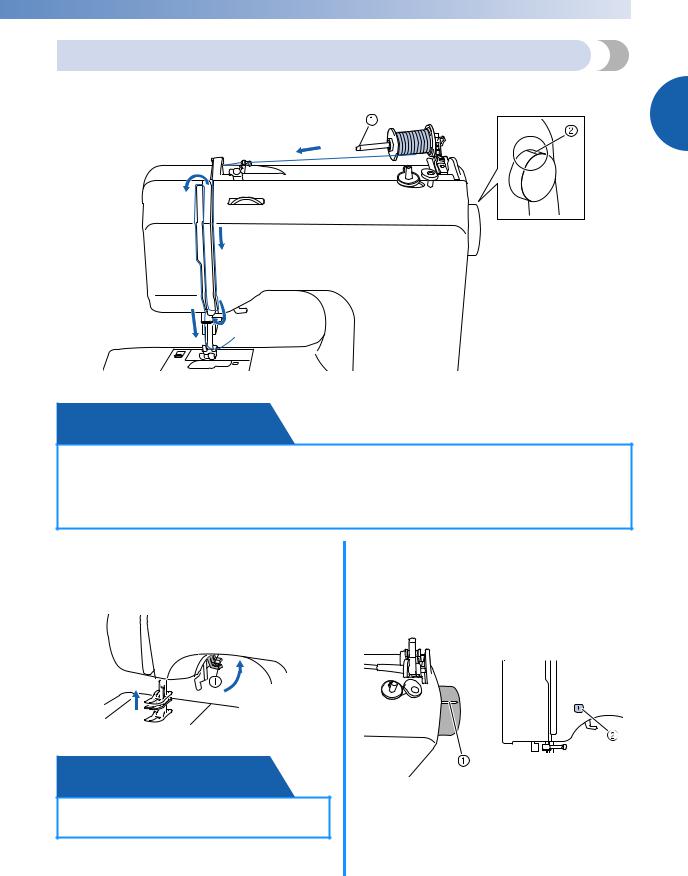
——————————————————————————————————————————————————————————————————————————————————————————————————————————————————————
Upper threading
Set the upper thread and thread the needle.
• For details on the needle threader, see page 28.
1
aSpool pin
bMark on the handwheel
 CAUTION
CAUTION
●When threading the upper thread, carefully follow the instructions. If the upper threading is not correct, the thread may become tangled or the needle may bend or break.
●Never use a thread weight of 20 or lower.
●Use the needle and the thread in the correct combination. For details on the correct combination of needles and threads, refer to “Needle types and their uses” (page 31).
aTurn on the sewing machine.
bRaiselever.the presser foot using the presser foot
a Presser foot lever
 CAUTION
CAUTION
●If the presser foot is not raised, the sewing machine cannot be threaded correctly.
cRaise the needle by turning the handwheel toward you (counterclockwise) so that the mark on the wheel points up, or press  (needle position button) (for models equipped with the needle position button) once or twice to raise the needle.
(needle position button) (for models equipped with the needle position button) once or twice to raise the needle.
or
a Mark |
b Needle position button |
•If the needle is not correctly raised, the sewing machine can not be threaded. Be sure to turn the handwheel so that the mark on the wheel points up before threading the sewing machine.
25
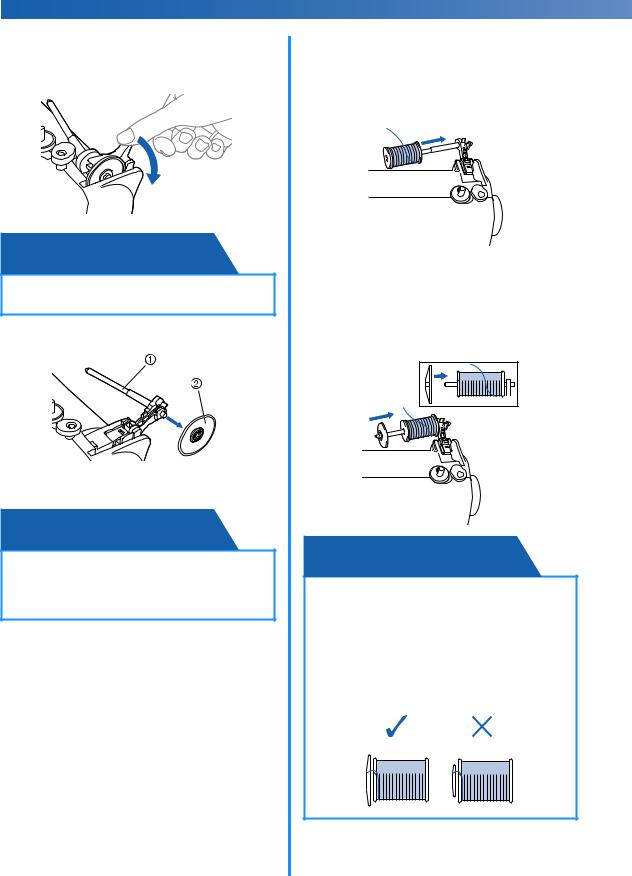
KNOWING YOUR SEWING MACHINE —————————————————————————————————————————————————————————————————————————————————
dAs shown, press down on the spool pin lever with your finger.
X The spool pin swings up.
 CAUTION
CAUTION
●Do not grab the bar to raise the spool pin, otherwise, the spool pin may bend or break.
eRemove the spool cap.
aSpool pin
bSpool cap
 CAUTION
CAUTION
●Be sure to raise the spool pin before use. If the spool of thread is in the wrong place, or is set incorrectly, the thread may tangle on the spool pin and cause the needle to break.
fFully insert the spool for the upper thread onto the spool pin.
Slide the spool onto the pin so that the spool is horizontal and the thread unwinds to the front at the bottom.
gSlide the spool cap onto the spool pin.
With the slightly rounded side of the spool cap positioned toward the left, slide the spool cap onto the spool pin as far as possible to the right so that the spool is moved to the right end of the spool pin.
 CAUTION
CAUTION
●If the spool or the spool cap is not positioned correctly, the thread may become tangled around the spool pin or the needle may break.
●Three spool cap sizes are available, allowing you to choose a spool cap that best fits the size of spool being used. If the spool cap is too small for the spool being used, the thread may catch on the slit in the spool or the needle may break.
26
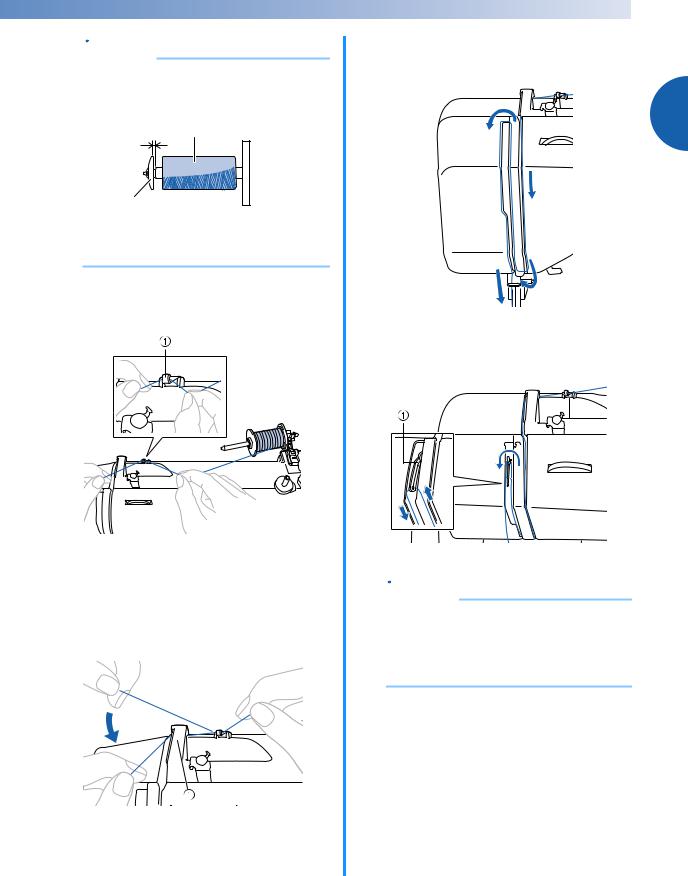
——————————————————————————————————————————————————————————————————————————————————————————————————————————————————————
 Memo
Memo
●When sewing with fine, cross-wound thread, use the small spool cap, and leave a small space between the cap and the spool.
c b
a 
aSpool cap (small)
bSpool (cross-wound thread)
cSpace
hWhile holding the spool with your right hand, and then pass the thread under the thread guide.
a Thread guide
iPass the thread under the thread guide cover from the back to the front.
Hold the thread with your right hand so that there is no slack in the thread that is pulled out, and then pass the thread under the thread guide cover with your left hand.
jFeed the upper thread as shown in the illustration below.
1
kMake sure you guide the thread through the thread take-up lever from right to left as shown in the illustration below.
a Thread take-up lever
 Memo
Memo
●If the needle is not raised, the thread takeup lever cannot be threaded. Be sure to press the needle position button to raise the needle before threading the thread take-up lever.
a Thread guide cover
27
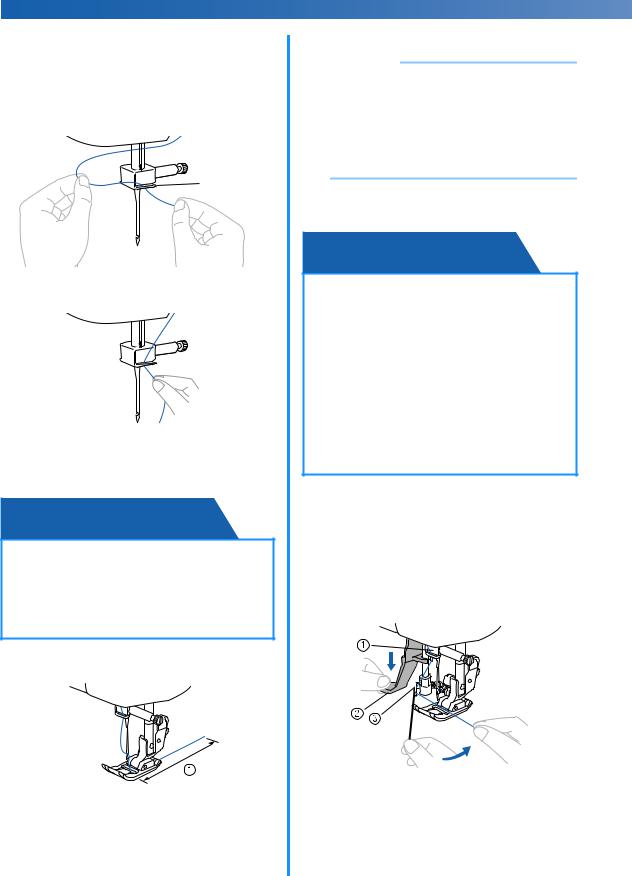
KNOWING YOUR SEWING MACHINE —————————————————————————————————————————————————————————————————————————————————
lPut the thread behind the needle bar thread guide above the needle.
The thread can easily be passed behind the needle bar thread guide by holding the thread in your left hand, then feeding the thread with your right hand.
1 |
a Needle bar thread guide
mTurn off the sewing machine.
 CAUTION
CAUTION
●Make sure you turn the power off while threading the machine without using the needle threader (for models equipped with the needle threader). If you accidentally step on the foot controller and the machine starts to sew, you could be injured.
nThread the needle from front to back and pull out about 5 cm (2 inches) of thread.
 Note
Note
●If the thread take-up lever is lowered, the upper thread cannot be wrapped around the thread take-up lever. Make sure you raise the presser foot lever and the thread take-up lever before you feed the upper thread.
●If you incorrectly feed the thread you may cause sewing problems.
■Using the needle threader (for models equipped with the needle threader)
 CAUTION
CAUTION
●The needle threader can be used with a 75/11 through 100/16 home sewing machine needle. However, the needle threader cannot be used with a 65/9 home sewing machine needle. When using special thread such as transparent nylon thread or metallic thread, the needle threader cannot be used.
●Thread with a thickness of 130/120 or thicker cannot be used with the needle threader.
●The needle threader cannot be used with the wing needle or the twin needle.
●If the needle threader cannot be used, refer to “Upper threading” (page 25).
aFollow steps a through m of the procedure in “Upper threading” to thread the machine to the needle bar thread guide.
bLower the presser foot lever.
cWhile lowering the needle threader lever, hook the thread onto the guide.
a Needle holder
b Needle threader lever
c Guide
a 5 cm (2 inches)
28
